Books Published 2008 - 2012
|
Second Edition of'Rockhopper Copper' by Conrad Glass
Review by Richard Grundy from the February 2012 Tristan da Cunha Newsletter
|
|
The life and times of the people of the planet's most remote inhabited island in the words of their Policeman and former Chief Islander Conrad Glass (now MBE) loses none of its charm and character in its second edition which has been again edited by Chris Bates. Whilst the text of the original chapters, covering the island's history, way of life and especially Conrad's stories of his adventures, around the islands as policeman and on longboat trips to Nightingale Island, remain fundamentally the same, the 'Personal Glimpses' section has been considerably extended to include a very good summary of recent events on the islands. An excellent new appendix 'Visiting Tristan' also provides a very helpful guide to the Tristan Association's work as well as sound advice for would-be visitors, while the style and layout has also been improved. No Tristan enthusiast should be without Rockhopper Copper and the second edition builds soundly on the first. I hope Conrad continues writing and perhaps a sequel could start with his interpretation of recent events like the amazing humpback whale story in this newsletter.
The book is published by Polperro Heritage Press (ISBN 9780955364877)
and is available from Miles Apart for £12 including P&P.
|
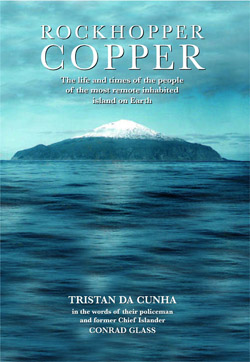
|
In November 2012 a Kindle version of Rockhopper Copper is available from retailers
The Amazon Kindle version of Rockhopper Copper (ISBN 978-0-9530012-3-1)
can be viewed and purchased (£6.83) via the following link:
http://www.amazon.co.uk/Rockhopper-Copper-ebook |
|
Gizi Map of St Helena and Dependencies
– including maps of Tristan da Cunha, Inaccessible and Gough Islands
Review by Richard Grundy from the February 2012 Tristan da Cunha Newsletter |
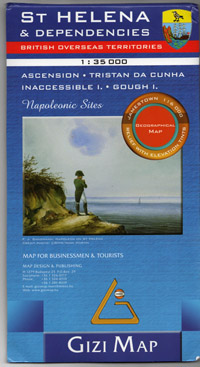
|
This new Gizi Map is the first map of the islands for at least twenty years so is a most welcome publication. A 1:35,000 map of St Helena which is ideal for visitors is supplemented with a useful 1:6,000 plan of central Jamestown and a small Atlantic Ocean map showing the positions of all the islands. The Ascension, Tristan, Gough and Inaccessible maps are at 1:75,000 scale with a 1:1,000,000 inset map showing the main Tristan group. Comprised of a typical folded sheet with card covers, it is a quality publication in terms of clarity using full colour to good effect with relief shading, but there are no contours and no key to the colours used to represent height. Spot heights in metres above sea level show significant summits, but those on the Tristan map are restricted to two on the peak. Drainage and place names are clearly marked but some Tristan place names are wrongly located. So Little Beach emerges from under the 1961 lava and is placed by Pigbite and Big Beach re-surfaces between Big Point and Rookery Point! Like other maps the Gizi map still erroneously marks 'The Farm' by Sandy Point, but this time moves it onto the Base. Nevertheless it is an attractive map, of good general quality and worth buying if you don't rely too much on the details!
The Gizi Map 2011 is available from Miles Apart for £11 including P&P.
|
|
Tristan da Cunha and the Tristanians
by Daniel Schreier and Karen Lavarello-Schreier
|
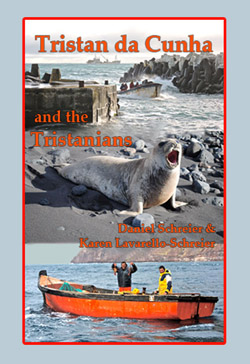 |
Dani Schreier is the leading expert on Tristan da Cunha English and a Professor at the University of Zurich's Department of English. Dani's Tristan work started with his PhD project (1997-2001) on Isolation and Language Change and he also completed a St Helena Language and History Project (2003-8). He has carried out two extended Tristan fieldwork trips in 1999 and 2010, the first of which introduced him to Karen Lavarello. They later married and Karen Schreier worked with Dani on this book which supercedes their first book: Tristan da Cunha: History, People, Language, published in 2003 and featured on our Books 2003-5 Page.
'Tristan da Cunha and the Tristanians' extends and updates their 2003 book. It has 128 pages, 50+ illustrations, ISBN 1903292263 and is published by Battlebridge in June 2011 and is available from Miles Apart for £12 including P&P. Profits from book sales will go towards the Tristan Disaster Fund following its establishment after the 2001 hurricane.
|
|
To quote from the publisher's summary: 'This book aims to provide the reader with everything they could wish to know about Tristan da Cunha, the world's most remote inhabited island. There are sections on how to get there, on its unusual history, on the people who live there and their way of life, and on the plants and animals which share this isolated territory with the human population. The book also includes a glossary of the special kind of English spoken there, and there are many pictures and photographs of the island and its islanders.'
|
| We will carry a review in the February 2012 Newsletter |
Mid Atlantic Village
by Jim Flint
Review by Michael Swales from the August 2011 Tristan Newsletter
|
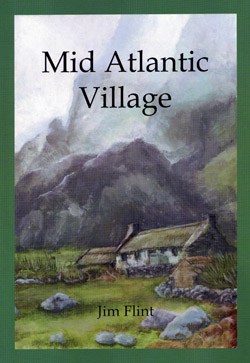 |
This recently published book is mainly personal reminiscences with illustrations by the school teacher who accompanied the Tristan Islanders on their return to the island in 1963. Towards the end he also brings the reader more up to date with changes since his time on the island.
This book makes fascinating reading, especially for those who have known Tristan da Cunha and its people over the years. Jim records not only detailed descriptions of the remotest island, but also what it was like living with the islanders in the tenuous days after their return. Compiled in the main from his diaries, he records what it was like to be as one of them, with details of their communication in the Tristan dialect.
Jim describes the re-establishment of the School with some details of the curriculum and insight into the children's future prospects. He also gives records of his trips overland and by longboat to various parts of the Island and to Nightingale. Along with his experiences are observations of the wildlife and its contribution towards sustaining the islanders in those difficult days.
|
|
In summary this book pays tribute to the people of Tristan and their re-adaptation to life in complete isolation, in contrast to what they had experienced during two years in England, and how they worked to re-establish a permanent settlement there. It is also a unique and entirely sympathetic insight by an outsider of daily life in this small and remarkable community. It is a recommended read for all interested in Tristan history too.
Copies of Mid Atlantic Village are available direct from Jim Flint,
150 Hoe Benham, Newbury, Berks RG20 8PD enclosing a cheque for £12.
Profits will be donated by Jim to the RSPB's 'Save the Albatross' campaign.
250 pages including 16 colour plates and 31 other illustrations.
|
Rockhopper Penguins and Other Songs
By the pupils of St Mary's School, Tristan da Cunha and Norfolk Music School, UK
Edited by Tony Triggs
|
|
This remarkable publication was introduced by Education Adviser Jim Kerr in the August 2010 Tristan Newsletter :
We should like to thank Ingrid van der Merwe who, before she left Tristan in March, enjoyed taking Class 3 for some English lessons, including leading the children in the writing of poetry that could be turned into song. Her efforts were rewarded and all the pupils in the class produced entertaining poems linked to their life on Tristan. I sent the poems to Tony Triggs who runs a music school in Norfolk. Tony is keen for the Norfolk Music School to develop links with St. Mary's School and he and his students set about writing music to accompany most of the poems. This project has been very successful, members of Class 3 are delighted with the results and we have started to learn some of the songs starting with 'Rockhopper Penguins', written by Kimberley Green and Tony Triggs. This project has resulted in some new friendships and some of Class 3 have started to communicate regularly with their partners in Norfolk. Tony has gathered the songs together in a book entitled 'Rockhopper Penguins and Other Songs', and Tristan pupils will be working enthusiastically on some new poems motivated by the lovely music from Norfolk.
Pictured below is Riaan Repetto
who wrote the poem 'A Molly'
which was set to music by Bethany Parker
from the Norfolk Music School.
|
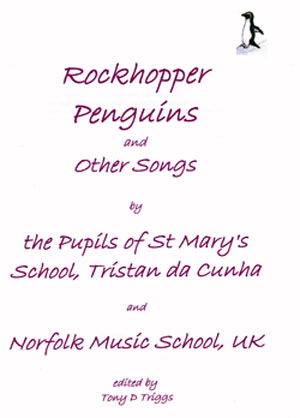
|
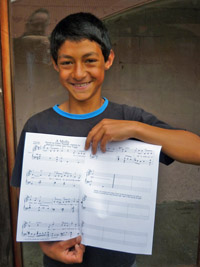 |
Copies of the collaborative book are available at £7.50 including P&P
from Tony Triggs
(to whom cheques should be made payable)
Norfolk Music School, Mere House, Brewery Road,
Trunch, North Walsham NR28 0PU, UK
Email: top.note@yahoo.co.uk
The book contains 14 songs – 13 with words by Tristan children and one called 'Ratting Day' with words from Jim Kerr. It is in A4 format and comb bound so that it opens flat. The songs are presented for treble voice and piano, and there are guitar chords too. Any profits from this edition will provide musical instruments for St Mary's School on Tristan.
Also available from Miles Apart |
|
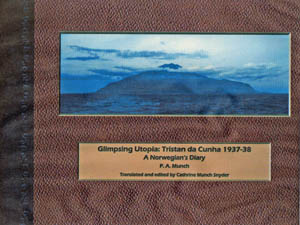
|
Glimpsing Utopia: Tristan da Cunha 1937-38
A Norwegian's Diary by Peter Munch
Translated and edited by Cathrine Munch Snyder
|
| Extracts for a review by Ian Mathieson,
first published in the August 2008 Tristan Newsletter
Peter Munch is best remembered for his book Crisis in Utopia which is the most likely book to be found on one of those lucky days when you find something on Tristan in your local second-hand shop. Crisis was written as a result of Munch's return to the Island following the re-settlement and draws only generally on his three month stay with the Norwegian Scientific Expedition from December 7th 1937 until March 29th 1938.
|
|
The information that Munch collected during those months on the manners, customs and nature of the Tristan islanders formed the basis of his doctoral thesis and was published in 1944 as Paper No 13 of the Results of the Expedition under the title the Sociology of Tristan da Cunha . This you most certainly won't find in a second-hand bookshop. Now with the publication of Munch's private diary of his time on the Island we are given a most interesting insight into a community just emerging from extreme isolation. Munch's daughter, Cathy Snyder, who features in the work as Munch's baby daughter Trine (who didn't accompany him), has been responsible for translating and editing her father's work and making, as she says, “a minimum of changes” from the original. The account is enlivened by Munch's photos of many of the Islanders' houses and activities but there are relatively few images of the Islanders themselves. Perhaps this was an editorial decision.
Munch's approach to his work was to use “participant observation” so as “to observe meaningful action in a context that will minimize the (interference) of the investigator's preconceived meanings, attitudes and values. To understand from inside the cultural situation”. It is evident from the diary that this is exactly what he achieves with fine descriptions of most of the activities that made up the Islander's lives at the time. While this is of interest for Island enthusiasts & researchers, what makes the story move along and have narrative drive is the recording of the extraordinary antics of the Island chaplain Harold Wilde: the latest in a succession of missionaries sent by the SPG whose contribution to Island life could hardly be seen to be positive. Munch recounts the excesses of Wilde's predecessor Partridge who punished Islanders by flogging and holding them in stocks while Wilde's approach was more subtle through control of the Islanders' supplies and by vague references to the displeasure of authorities in England if the residents behaved in a manner of which he did not approve.
Glimpsing Utopia is a most worthy addition to Tristan's expanding literature and another Tristan title chalked up by George Mann Publications; the author has been well served by an attractive book designed to give the feel of a personal diary.
|
Glimpsing Utopia is published by George Mann Publications 2008.
It has 210 pages, numerous black and white illustrations, and is available from Miles Apart at £20 including postage and packing.
|
|







